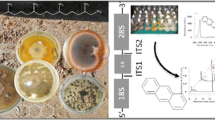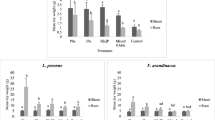Abstract
Purpose
Polycyclic aromatic hydrocarbons (PAHs) are a class of organic compounds commonly found as soil contaminants. Fungal degradation is considered as an environmentally friendly and cost-effective approach to remove PAHs from soil. Acenaphthylene (Ace) and Benzo[a]anthracene (BaA) are two PAHs that can coexist in soils; however, the influence of the presence of each other on their biodegradation has not been studied. The biodegradation of Ace and BaA, alone and in mixtures, by the white rot fungus Pleurotus ostreatus was studied in a sandy soil.
Materials and methods
Experimental microcosms containing soil spiked with different concentrations of Ace and BaA were inoculated with P. ostreatus. Initial (t 0) and final (after 15 days of incubation) soil concentrations of Ace and BaA were determined after extraction of the PAHs.
Results and discussion
P. ostreatus was able to degrade 57.7% of the Ace in soil spiked at 30 mg kg−1 dry soil and 65.8% of Ace in soil spiked at 60 mg kg−1 dry soil. The degradation efficiency of BaA by P. ostreatus was 86.7 and 77.4% in soil spiked with Ace at 30 and 60 mg kg−1 dry soil, respectively. After 15 days of incubation, there were no significant differences in Ace concentration between soil spiked with Ace and soil spiked with Ace + BaA, irrespective of the initial soil concentration of both PAHs. There were also no differences in BaA concentration between soil spiked with BaA and soil spiked with BaA + Ace.
Conclusions
The results indicate that the fungal degradation of Ace and BaA was not influenced by the presence of each other’s PAH in sandy soil. Bioremediation of soils contaminated with Ace and BaA using P. ostreatus is a promising approach to eliminate these PAHs from the environment.



Similar content being viewed by others
References
Acevedo F, Pizzul L, Castillo MP, Cuevas R, Diez MC (2011) Degradation of polycyclic aromatic hydrocarbons by the Chilean white-rot fungus Anthracophyllum discolour. J Hazard Mater 185:212–219
Andersson BE, Lundstedt S, Tornberg K, Schnürer Y, Öberg LG, Mattiasson B (2003) Incomplete degradation of polycyclic aromatic hydrocarbons in soil inoculated with wood-rotting fungi and their effect on the indigenous soil bacteria. Environ Toxicol Chem 22:1238–1243
Bakker MI, Casado B, Koerselman JW, Tolls J, Kolloffel C (2000) Polycyclic aromatic hydrocarbons in soil and plant samples from the vicinity of an oil refinery. Sci Total Environ 263:91–100
Bamforth SM, Singleton I (2005) Bioremediation of polycyclic aromatic hydrocarbons: current knowledge and future directions. J Chem Technol Biotechnol 80:723–736
Beckles DM, Ward CH, Hughes JB (1998) Effect of mixtures of polycyclic aromatic hydrocarbons and sediments on fluoranthene biodegradation patterns. Environ Toxicol Chem 17:1246–1251
Bhatt M, Cajthaml T, Šašek V (2002) Mycoremediation of PAH-contaminated soil. Folia Microbiol 47:255–258
Cajthaml T, Erbanová P, Šašek V, Moeder M (2006) Breakdown products on metabolic pathway of degradation of benz[a]anthracene by a ligninolytic fungus. Chemosphere 64:560–564
Gao D, Du L, Yang J, Wu WM, Liang H (2010) A critical review of the application of white rot fungus to environmental pollution control. Crit Rev Biotechnol 30:70–77
Haritash AK, Kaushik CP (2009) Biodegradation aspects of polycyclic aromatic hydrocarbons (PAHs): a review. J Hazard Mater 169:1–15
Johnsen AR, Wick LY, Harms H (2005) Principles of microbial PAH-degradation in soil. Environ Pollut 133:71–84
Kanaly RA, Harayama S (2000) Biodegradation of high-molecular-weight polycyclic aromatic hydrocarbons by bacteria. J Bacteriol 182:2059–2067
Lau EV, Gan S, Ng HK (2010) Extraction techniques for polycyclic aromatic hydrocarbons in soils. Int J Anal Chem 2010(398381)
Majcherczyk A, Johannes C, Hüttermann A (1998) Oxidation of polycyclic aromatic hydrocarbons (PAH) by laccase of Trametes versicolor. Enzyme Microb Tech 22:335–341
Meharg AA, Wright J, Dyke H, Osborn D (1998) Polycyclic aromatic hydrocarbon (PAH) dispersion and deposition to vegetation and soil following a large scale chemical fire. Environ Pollut 99:29–36
Moody JD, Freeman JP, Cerniglia CE (2005) Degradation of benz[a]anthracene by Mycobacterium vanbaalenii strain PYR-1. Biodegradation 16:513–526
Nadal M, Schuhmacher M, Domingo JL (2004) Levels of PAHs in soil and vegetation samples from Tarragona County, Spain. Environ Pollut 132:1–11
Nayak AS, Veeranagouda Y, Lee K, Karegoudar TB (2009) Metabolism of acenaphthylene via 1,2-dihydroxynaphthalene and catechol by Stenotrophomonas sp. RMSK. Biodegradation 20:837–843
Riding MJ, Doick KJ, Martin FL, Jones KC, Semple KT (2013) Chemical measures of bioavailability/bioaccessibility of PAHs in soil: fundamentals to application. J Hazard Mater S0304–3894(13):00220–00223
Rosales E, Pérez-Paz A, Vázquez X, Pazos M, Sanromán MA (2012) Isolation of novel benzo[a]anthracene-degrading microorganisms and continuous bioremediation in an expanded-bed bioreactor. Bioprocess Biosyst Eng 35:851–855
Rostami I, Juhasz AL (2011) Assessment of Persistent Organic Pollutant (POP) bioavailability and bioaccessibility for human health exposure assessment: a critical review. Crit Rev Env Sci Tec 41:623–656
Sang LZ, Wei XY, Chen JN, Zhu YZ, Zhang Y (2009) Simultaneous fluorimetric determination of the biodegradation processes of dissolved multi-component PAHs. Talanta 78:1339–1344
Song YF, Jing X, Fleischmann S, Wilke BM (2002) Comparative study of extraction methods for the determination of PAHs from contaminated soils and sediments. Chemosphere 48:993–1001
US EPA (1994) EPA Method 3541, Automated Soxhlet extraction. SW-846, Test methods for evaluating solid waste, physical/chemical methods. United States Environmental Protection Agency
Wolter M, Zadrazil F, Martens R, Bahadir M (1997) Degradation of eight highly condensed polycyclic aromatic hydrocarbons by Pleurotus sp. Florida in solid wheat straw substrate. Appl Microbiol Biotechnol 48:398–404
Acknowledgments
R.S. Oliveira wishes to acknowledge the support of Fundação para a Ciência e a Tecnologia through the research grant SFRH/BPD/85008/2012 and Fundo Social Europeu.
Author information
Authors and Affiliations
Corresponding author
Additional information
Responsible editor: Jaume Bech
Rights and permissions
About this article
Cite this article
Rocha, I., Pinto, E., Ferreira, I.M.P.L.V.O. et al. Influence of mixtures of acenaphthylene and benzo[a]anthracene on their degradation by Pleurotus ostreatus in sandy soil. J Soils Sediments 14, 829–834 (2014). https://doi.org/10.1007/s11368-013-0804-1
Received:
Accepted:
Published:
Issue Date:
DOI: https://doi.org/10.1007/s11368-013-0804-1




